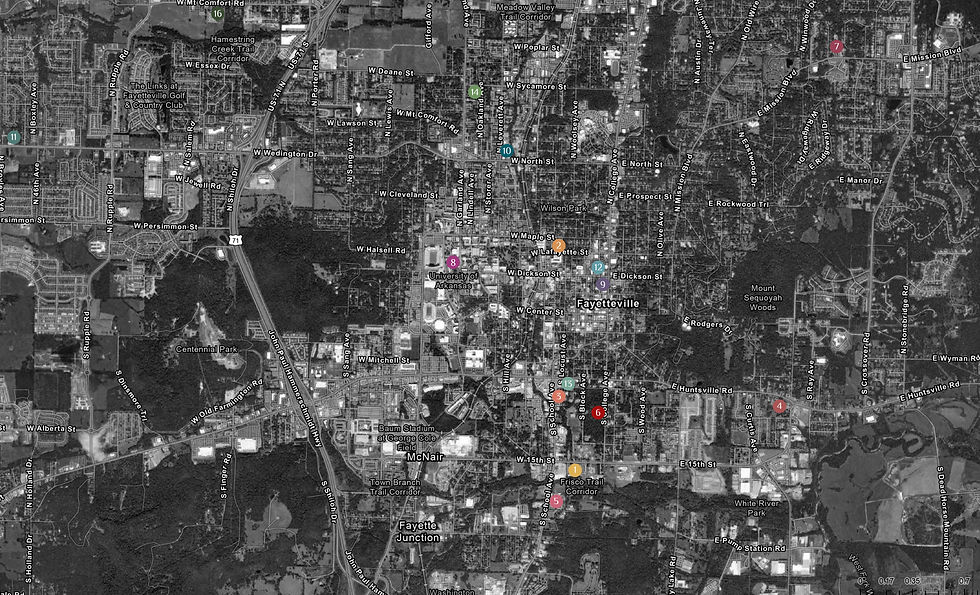Sound + Materials
- cnlents
- Oct 27, 2022
- 4 min read
Updated: Dec 11, 2022
The impact that noise and materials can have on one's experience of a space is often underestimated until it becomes a problem. People tend to not notice a space with really good acoustics or materials that are comfortable unless you're trained to look at those things. But as soon as that material becomes uncomfortable or noises in space become too loud more people will notice and complain about it. So to find the sources of noise pollution and poor materials in a city, one simply needs to look for the area that gets the most complaints or what ordinances the city has in place. This makes the task immensely less daunting.
Noise Ordinances:
It is so important to look at both noise levels and materials, but it is not done as often because of the more tangible and experiential nature of them. So to begin the investigation of sound and materials in Fayetteville, the first thing I looked at was if there was a noise ordinance in Fayetteville. And of course, there was. On the City of Fayetteville Arkansas website it says that the noise ordinance in Fayetteville says:
Sound (music) coming from a vehicle at any time should not be heard from a distance greater than 30 feet and plainly audible. Between the hours of 1 AM to 8 AM, noise coming from a business or residence that can be heard from a distance greater than 150 feet from the business or residences is a violation of the City's noise ordinance. Violations at any other time will be determined by a sound meter reading taken from the property line by a certified officer. Use of compression release engine brakes is prohibited in the city limits.
Beyond this it seems, there don't seem to be many regulations when it comes to noise in Fayetteville. Some neighborhoods or areas do have additional rules in place, but those are isolated and I could not find any that had to do with my personal neighborhood.
What gets the most Noise Complaints?
The only thing I was able to find beyond complaints about parties or in areas where you expect noise was about the Bikes, Blues, and BBQ events. This event is where about 400,000 bikers come to Fayetteville in September for their annual celebration. This event is not the norm for day-to-day activities so it may not be that helpful to look at. A majority of the noise complaints made in Fayetteville are likely about college kid parties. But even these are temporarily elevated noise levels. So what about the major sources of noise that are more constant?
Major Noise Sources:
Based on my own experience in Fayetteville, I would say that the major noise sources are I-49 and the various sports facilities on and around campus. I-49 gets a lot of traffic pretty much constantly with people commuting for work and semi-trucks using it as a major trucking route. Plus it runs through the center of town pretty much. I think that traffic noise overall is one of the biggest noise sources for Fayetteville because of how car-based it is. It is pretty ineffective to walk anywhere because of how much longer it takes due to how spread out and hilly the city is. Walking 3 miles up and down hills to go get milk from Walmart is not very productive. As for the sports facilities, there is almost always some kind of sports event or practice going on that can be heard from far away. Particularly Football games, Baseball games, and Band Practices. I can hear all 3 of these loud and clear from either my home or school or sometimes both. The map below supports my initial thoughts by highlighting I-49 and other major roadways as the main noise pollutants for my community. The house on the map indicates the location of my work/school because that is where I spend a majority of my time. This map came from HowLoud.

Noise on the inside?
From my personal experience at school and home, there are only a few things that I can think of about noise. The first thing I thought of is the bathrooms in the Fay Jones Building on campus. Those single-stall bathrooms on the first, second, and third floors echo like there is no tomorrow. You can hear anything and everything going on in those from the studios next to them. Another example I can think of is the study rooms in Mullins. They do not block any noise at all. You can hear whatever the people in the rooms are talking about in the open desk areas.
Now What About Materials?
Understanding the impact of materials at the scale of a city is much more complicated. The main thing that applies is the recycling and waste disposal systems in place in Fayetteville. There is a big push to reduce solid waste reduction. The current master plan has a goal of achieving 40% waste diversion by 2027. The breakdown of materials discarded in Fayetteville is as follows:

Resources:




Comments